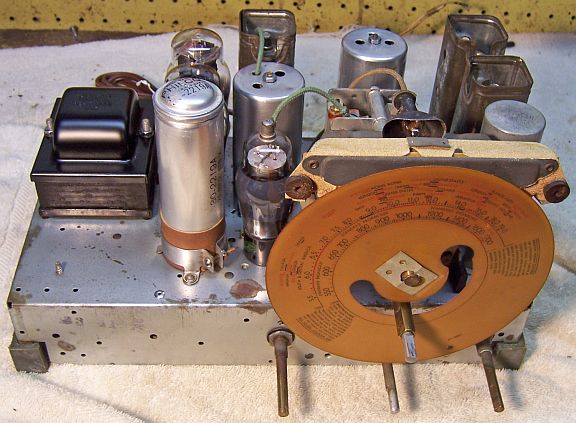Posts: 16
Threads: 4
Joined: Sep 2011
City: Fairfield, OH
Hello. Wanting to remove this dial for safekeeping while I clean the tuning cap and chassis. I removed the rectangular clip on the front of the dial but the dial stills seems solidly adhered to the hub behind it. Am I missing something simple? Thanks.
Posts: 7,295
Threads: 268
Joined: Dec 2009
City: Roslyn Pa
Got something that's worth a thousand words??
When my pals were reading comic books
I was down in the basement in my dad's
workshop. Perusing his Sam's Photofoacts
Vol 1-50 admiring the old set and trying to
figure out what all those squiggly meant.
Circa 1966
Now I think I've got!
Terry
Posts: 1,531
Threads: 242
Joined: Sep 2012
City: West Bend, Wisconsin
Can't recall for sure but am thinking it comes off the same as this dial scale on the model 630 (within the first 90 seconds of this video)
https://www.youtube.com/watch?v=B9_z2jEDnDo&t=316s
Greg V.
West Bend, WI
Member WARCI.org
Posts: 16
Threads: 4
Joined: Sep 2011
City: Fairfield, OH
Thanks for the video, Greg. That's how the dial on my 620 is attached but the 38-10 is different. Looking at it more closely I can see a thin layer of rubber, as thin as paper, sandwiched between the dial and the hub behind it. That rubber has effectively glued the dial in place. Rather than risk damaging the dial trying to remove it I will clean the tuning cap as best as I can with the dial in place. Thanks for the responses.
Posts: 2,573
Threads: 337
Joined: Jun 2013
City: lawrenceville nj
Terry
Play nice and just ask for a close up picture

Sam
Some day, and that day may never come, I will call upon you to do a service for me. But until that day, accept this justice as a gift
mafiamen2
Posts: 1,531
Threads: 242
Joined: Sep 2012
City: West Bend, Wisconsin
Does it have a flat clip like this?

If so the clip slides so that the exposed hole moves over the shaft. Use a needle nose pliers, sticking one end into one of the small holes, and the other end on the opposite side of the center shaft and squeeze.
Greg V.
West Bend, WI
Member WARCI.org
Posts: 16
Threads: 4
Joined: Sep 2011
City: Fairfield, OH
Yes, Greg, that is what my chassis looks like and yes, I was able to slide off that front clip. As noted above the problem is that the dial is adhered to a thin sheet of rubber between it and the plate that attaches to the end of the tuning shaft. I have elected to leave well enough alone for fear of damaging the dial trying to remove it.



![[-] [-]](https://philcoradio.com/phorum/images/bootbb/collapse.png)


